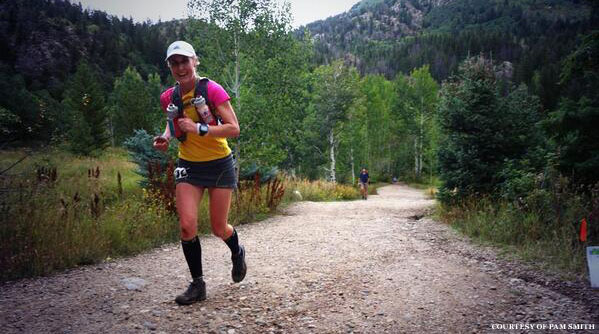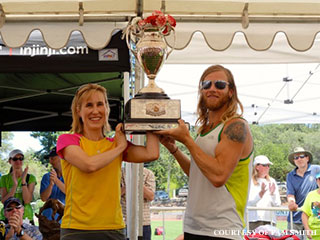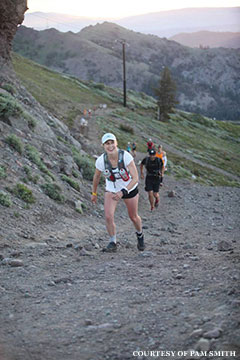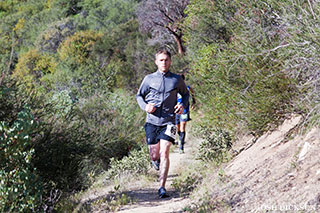An elite ultramarathon runner can start a race like the Western States 100-Mile Endurance Run when The Today Show begins Monday morning and finish it by the time it ends ... on Tuesday. They can run a marathon, and then another one, and another one, and another one without taking a break. And they can do this not on the mostly flat, forgiving streets of Boston or New York City, but on ragged terrain like trails in the Sierra Nevada mountains. They run when it's freezing cold and when it's steamy hot. They run -- a lot -- often for 100 miles at a time through thousands of feet of elevation.
This is why Pam Smith, 38, the 2013 Western States female champion, says the focus in ultramarathon running is on the accomplishment of completing the course, rather than watching the clock.

"When I ran marathons, I would be beating myself up to take two or three minutes off of my time," she says. "I think one reason that people move to ultras is to get away from the road. People can challenge themselves without the pressure of running a specific time."
With the clock out of the way, runners can focus on more pressing matters, like finishing the race in one piece.
Ultramarathons are defined as any race longer than a marathon. They usually come in four different varieties: the 50k, the 50-miler, the 100k and the 100-miler.

"Most people start with a 50k," Smith says. "It's basically a marathon plus five miles. If you run marathons routinely, the extra five miles doesn't seem so bad. You can sort of just push through that. I try and convince all of my friends to do it. When you run a marathon, you're pushing the red line for the whole 26 miles. At 50 and above, you may have sections where you might be walking or stop at an aid station. It mitigates some of the pain."
The pain, for those who haven’t experienced it, can run from complete loss of energy, to agony and disorientation. Such is the natural result of entering a race that may take you 30 hours to finish.
"The fatigue can get overwhelming," Smith says. "It also becomes challenging and difficult to manage. You come up with mental strategies to overcome it. A good one for me is breaking the course down in sections. I'll think to myself that I have five more miles until an aid station, or three more miles until I reach the top of a hill. I like to run the race in little chunks, but you have to have that mindset that you're committed to finishing it. In every race, there's a period where you're hurting or you'd prefer to stop. The hardest part in the 100-mile race is in the 45-60 mile range. At that point you've gone quite a distance and you still have 40-45 miles left."
Josh Dickson, 29, a veteran marathon runner, competed in the 2013 Western 100 with Pam Smith and 383 other starters (only 277 finished). While Dickson has numerous marathons and ultras to his credit, the Western, which he describes as the ultimate ultramarathon, is a different animal.

"In a 100-miler, you hit that point where you want to quit a lot of times," he says. "People talk about getting a second wind, but you need a seventh and eighth wind to get through these. Most ultras are trails, and you're talking about rocky, root-filled trails which slow you down. The cumulative effect of that and the heat, it beats you down a bunch. At mile 30, you're feeling pretty good, looking over the mountainside, but by mile 38, you start to get a little groggy. It was over 100 degrees the day of the Western and the heat kicked in and it was tough to handle. I had a pretty tough bout between mile 40 and 50."
Smith knew the heat was going to be a problem and tried to game plan accordingly.
"I knew from the forecast that it was going to be a really hot year," she says. "I wore a cotton T-shirt because it holds moisture closer to your body. I also took all nine of my water bottles and froze them half with ice and filled the rest with water, so that the bottles themselves would keep me cool."
Staying hydrated and staying cool are the only ways to stave off the major issues brought on by the elements, namely cramps, overheating, dehydration and a general physical breakdown. Smith says that the wetter you can stay to beat the heat, the better.
"I put ice everywhere I could put it," Smith says. "I put it in my hat, my bra, my bandana. I splashed in every stream and river crossing. I made sure that I was soaking wet and got my body temperature down so that my running wasn't affected by the heat."
Races like the Western States typically start early in the morning, since many runners will be forcing one foot in front of the other for well over a day. This means that in addition to the physical pain of pounding the pavement, runners must also contend with the effects of sleep deprivation. Smith, who was the fastest woman in the Western, finished ninth overall with a time of 18:37.21. While the winner, Timothy Olsen, finished in just over 15 hours, only a third of the runners finished in under 24 hours. Dickson finished in about 25 hours, putting him in the middle of the pack.

To get ready for the 5 a.m. start time, Dickson woke up at 3 a.m. At the midway point of his run, about 6 p.m. that day, he'd already been awake for 15 hours.
"I was feeling good through about mile 70," he says. "Then the sleep deprivation starts kicking in. It felt like I was just wandering in the darkness. My little brother was with me, which was good because I was having mild hallucinations. Between mile 78 and 93, it was just absolute hell. "
So why do it?
Dickson paraphrases a quote from Ernest Hemingway:
"Everyone is broken by life, but some people are stronger in the broken places."
"I think ultras embody that whole mentality," he says. "It's just you against you. The course isn't going to move or change for you. You just have to keep going. It helps you prove yourself to yourself. If you can go through that type of physical and mental battle, I think it makes you a stronger person. It pushes you to a place that's hard to get to ... where you're that stripped bare and broken down in a moment."
Smith describes what she gets out of running by recalling the one DNF (did not finish) she has in an ultra.
"I didn't finish the Angeles Crest in 2010," she says. "It was a complete mental breakdown. I lined up and I just wasn't excited to run that weekend. I just felt like it was going to be terrible. I was a little fatigued and over trained. My knee started hurting and it wasn't something that should have been a race ending injury, but I just got into this negative mindset. I couldn't keep myself going to the finish line. I just decided to call it a day. In retrospect, my head was not in it from the get-go that day and I was relieved when they cut off my bracelet."

Preparing for a 100-mile marathon takes several months of training, often knocking out 100 miles of road work per week. For Smith, the decision to give up was almost as painful as the race itself, considering all the time and effort it took just to compete.
"When the day got hard, I called it quits," she says. "That prompted me to be more resilient. In the 2012 Western, I ran a terrible race. I had hypothermia, asthma, weight gain from fluid retention. The Western is usually very hot, but instead it was 40 miles of snow and sleet and rain. I just had gloves and arm sleeves. No jacket, nothing. The officials put me on a medical hold for two hours. When I was ready to leave, they made me sign a medical waiver before I left the tent, acknowledging that I could die on the trail and there might be no aid... But I finished."
Counter that with the 2013 race one year later, where Smith was victorious, and Hemingway's quote rings all the more true. Then again, in this case, a quote by Friedrich Nietzche may be more apt when talking about ultramarathons:
"That which does not kill us makes us stronger."
-- Jon Finkel is the author of The Dadvantage: Stay In Shape On No Sleep With No Time And No Equipment. Follow him on Twitter @Jon_Finkel.




